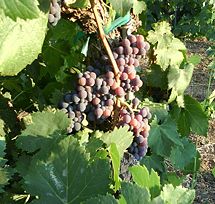Sangiovese
| Sangiovese | |
|---|---|
 |
|
| Sangiovese grapes still ripening on the vine | |
| Color of berry skin: | Purple |
| Species: | Vitis vinifera |
| Also called: | Brunello, Sangiovese Grosso (more) |
| Origin: | Italy |
| Notable regions: | Tuscany |
| Hazards: | Rot-prone |
|
Sangiovese is a red wine grape variety originating in Italy whose name derives from sanguis Jovis, "the blood of Jove". It is most famous as the main component of the Chianti blend in Tuscany, but winemakers outside Italy are starting to experiment with it. Young sangiovese has fresh fruity flavours of strawberry and a little spiciness, but it readily takes on oaky, even tarry, flavours when aged in barrels.[1]
History
Sangiovese appears to have originated in Tuscany, where it was known by the 16th century. Recent DNA research by José Vouillamoz of the Istituto Agrario di San Michele all’Adige suggests that Sangiovese's ancestors are Ciliegiolo and Calabrese Montenuovo. The former is well known as an ancient variety in Tuscany, the latter is an almost-extinct relic.[2]
There are 14 clones of Sangiovese,[3] of which Brunello is one of the best regarded. There was an attempt to classify the clones into Sangiovese grosso (including Brunello) and Sangiovese piccolo families, but there seems to be little evidence to support this distinction.[3]
Distribution and Wines
Australia
Sangiovese is becoming increasingly popular as a red wine grape in Australia, having been introduced by the CSIRO in the late 1960s.[4] This is part of a growing trend in Australia to use a wider range of grape varieties for winemaking. Some wineries also use Sangiovese to make rosé wines. 2006 was the first year that an Australian wine maker made a dessert style Sangiovese. Called the "Dolce Nero" (sweet black - not to be confused with the synonym for Dolcetto or Douce Noir) this new style is made by Hamiltons Bluff wines in Canowindra NSW.
The Chalk Hill winery has released a Sangiovese with an alcohol level of 16%, one of the highest levels of any wine.
Italy
The traditional home of Sangiovese is in Tuscany, although it has spread to other regions of Italy. Although it can be found as a varietal, and as a single-variety wine such as Brunello di Montalcino, Rosso di Montalcino or Sangiovese di Romagna, Sangiovese is most often found as the major component of blends such as Chianti, Vino Nobile di Montepulciano and Morellino di Scansano. The grape is also used to make some modern "Super Tuscan" wines like Tignanello.
Nowadays practically all Sangiovese in Tuscany is either Brunello or a very similar clone.
USA
Italian immigrants brought Sangiovese to California in the late 1800s [3], possibly at the Segheshio Family's "Chianti Station," near Geyserville. But it was never considered very important until the success of the Super Tuscans, since then there has been renewed interest in the grape. It has begun to be used more frequently in the Monticello wine region in Virginia by a number of winemakers with a fair amount of success.
Vine and Viticulture
Sangiovese vines are generally quite vigorous and disease resistant, but the berries are prone to rot. The small blue-black grapes are slow to ripen and thrive in hot, dry climates, but it is easy to produce quantity at the expense of quality. The grapes are 18.9mm long x 16.9mm wide, with an average weight of 3.00g.[5]
Synonyms
Brunello, Brunello Di Montalcino, Calabrese, Cardisco, Cordisio, Dolcetto Precoce, Ingannacane, Lambrusco Mendoza, Maglioppa, Montepulciano, Morellino, Morellone, Negretta, Nerino, Niella, Nielluccia, Nielluccio, Pigniuolo Rosso, Pignolo, Plant Romain, Primaticcio, Prugnolo, Prugnolo Di Montepulciano, Prugnolo Gentile, Prugnolo Gentile Di Montepulciano, Riminese, San Zoveto, Sancivetro, Sangineto, Sangiovese Dal Cannello Lungo, Sangiovese Di Lamole, Sangiovese Di Romagna, Sangiovese Dolce, Sangiovese Gentile, Sangiovese Grosso, Sangiovese Nostrano, Sangiovese Toscano, Sangioveto Dell'Elba, Sangioveto Dolce, Sangioveto Grosso, Sangioveto Montanino, Sanvincetro, Sanzoveto, Tignolo, Tipsa, Toustain, Uva Abruzzi, Uva Tosca, Uvetta,[5] San Gioveto, Uva brunella and Uva Canina.[4]
See also
Notes and references
- ↑ Robinson, Jancis (2006). The Oxford Companion to Wine, third edition. Oxford University Press. ISBN 0-19-860990-6..
- ↑ Italian grape mysteries unraveled jancisrobinson.com
- ↑ 3.0 3.1 3.2 [1]
- ↑ 4.0 4.1 State Library of South Australia
- ↑ 5.0 5.1 Maul, E.; Eibach, R. (1999-06-00). "Vitis International Variety Catalogue". Information and Coordination Centre for Biological Diversity (IBV) of the Federal Agency for Agriculture and Food (BLE), Deichmanns Aue 29, 53179 Bonn, Germany. Retrieved on 2007-06-16.
Further reading
- Robinson, Jancis Vines, Grapes & Wines Mitchell Beazley 1986 ISBN 1857329996
External links
|
|||||||||||||||||
|
|||||